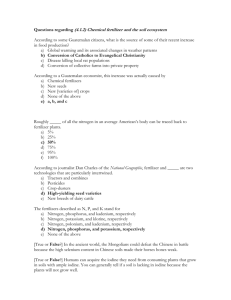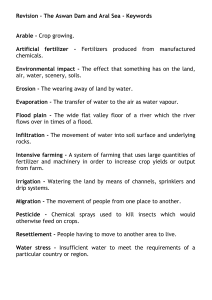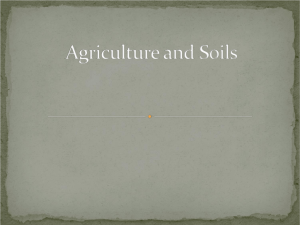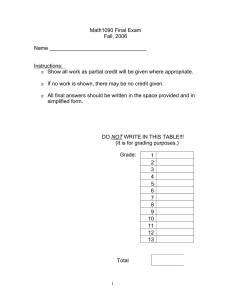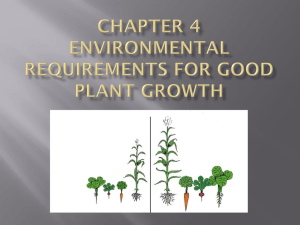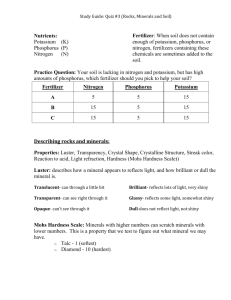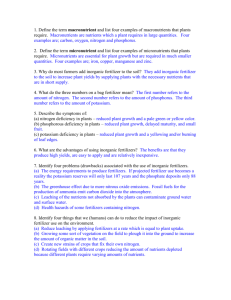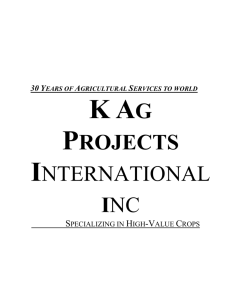For Vegetable Crops Fertilizers
advertisement
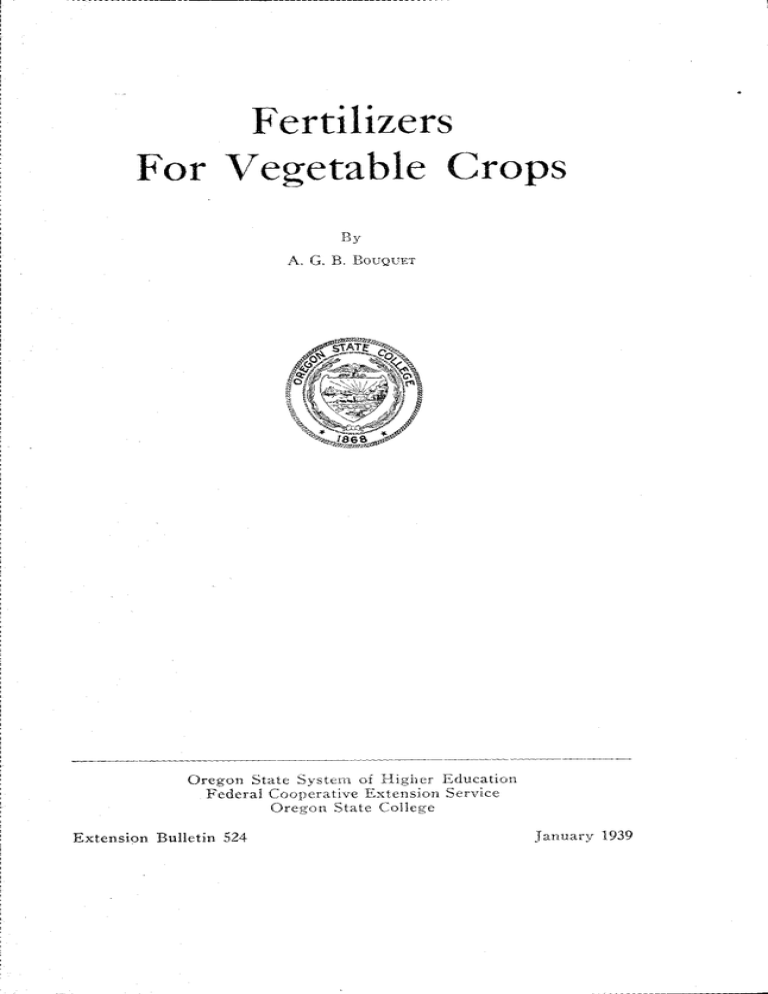
Fertilizers For Vegetable Crops By A. G. B. BOUQUET Oregon State System of Higher Education Federal Cooperative Extension Service Oregon State College Extension Bulletin 524 January 1939 SUMMARY To produce large crop yields of high quality per acre, a vegetable grower must follow a generous program of soil improvement and fertilization. Organic matter, by improving the structure of soils, increasing the number of beneficial soil organisms, and providing plant nutrients, plays an important part in vegetable-crop production. Stable manures, protected from leaching and fire fanging, provide a valuable source of humus and plant foods. Cover crops are of much value in both commercial and home gardens. Besides furnishing large quantities of humus, they supply plant food economically, and protect the soil from erosion and leaching. In conjunction with the use of stable manures and cover crops commercial fertilizers are often applied to advantage to supply readily available plant food. Nitrogen is more likely to be a determining factor in crop growth than phosphorus or potash. The efficiency of nitrogen in general seems to be increased where materials supplying phosphorus and potash are used with it. Phosphorus is valuable in stimulating root growth, encouraging blossom formation, and hastening maturity. Potash is especially useful in the growing of roots, fruiting, and leafy crops. A number of important vegetable crops remove considerable quantities of potash from the soil. The efficient use of commercial fertilizers is affected by several important crop-growing practices discussed in the text of this publication. A vegetable crop makes its best growth and produces the highest yield in soil that has a reaction or pH most suited to it. It is important to consider the soil reaction in connection with a fertilizing program. Analyses of complete fertilizers selected for a certain crop are chosen chiefly in consideration of the crop and the soil on which it is grown. Brands of complete fertilizers should be selected by the grower on the basis of the relative percentage of nitrogen, phosphoric acid, and potash in the fertilizer. Home-mixed fertilizers are likewise compounded on a similar basis. It is important to consider methods of placing fertilizer as effecting economy in cost and higher yields of the crop. The value of minor plant food elements such as boron, manganese, zinc, copper, and others has recently become more apparent in their effects on the health and growth of vegetable plants. Programs of fertilizing land for important vegetable crops are discussed in the bulletin. Suggestions of advantage to the commercial grower may be obtained from county agricultural agents, well acquainted with soil types and compositions in the respective counties. 1 I j '4 Fertilizers for Vegetable Crops By A. G. B. BOUQUET Horticulturist (Vegetable Crops) T N growing vegetables, unusually good soil conditions are necessary, not I only for commercial crop production, but also in the garden for home use. The land must have good structure and must be above the ordinary in fertility. To be successful in producing large crop yields of high quality, a vegetable grower must operate with a generous program of soil fertilization. Some of the fundamentals and practices in vegetable soil fertilization are discussed in this publication. Maintaining humus. Organic or vegetable matter in the process of decay in the soil forms humus, which plays a most important part in vegetable-crop production. Humus benefits the soil in various ways. It supplies food for beneficial micro-organisms, increases the water-holding capacity of the soil, permits better movement of water, improves soil aeration, adds plant food, and liberates plant nutrients. It improves the structure of both light and heavy soils. It improves sandy soils by filling spaces between the soil particles, and making them more retentive of moisture. It improves clay soils by making them more friable and less likely to puddle. The usefulness of well-decayed vegetable matter is obvious when it is realized that 100 pounds of sand, clay, and humus will absorb 25, 50 and 190 pounds of water respectively. The practice of supplementing soil organic matter by plowing down crop residues, animal manures, and green manures, is fundamental in main- taining the humus of a productive soil. When the land is cropped frequently, as in the case of vegetable production, the humus is rapidly depleted, as a result of the various oxidation processes of the soil, and must be renewed by the decomposition of old root systems, top growth, and other bulky organic material plowed into the soil. Crop residues and weeds in themselves usually do not furnish sufficient organic matter. Definite provision must be made in the cropping system for the incorporation of humus-forming material. Manures. In the early days of commercial vegetable growing, stable manure was the only fertilizing material applied to the soil. With the increase in acreage of land planted to vegetables and the decrease of animals in and about cities, the supply of stable manure in many instances is inadequate to furnish sufficient humus and fertilizing materials to maintain production. Where stable manure is available, the greatest economy in its care and use should be practiced. While the best practice of the vegetable grower, from the standpoint of conserving plant nutrients, would be to apply manure directly to the soil as soon as it is produced, that is not always possible because the land may be cropped or may be too wet and soft to permit hauling. In that case, suitable cover should be provided for temporary storage of the manure. Failure to cover stored manure is a wasteful practice, particu- larly in Western Oregon, where rains cause heavy leaching of plant foods. Covered manure should be kept moist by adding water so as to prevent burning or fire-fanging. 3 EXTENSION BULLETIN 524 To prevent loss of nitrogen in the form of ammonia, 75 pounds of superphosphate, 18 per cent, should be mixed with each ton of manure as it is being composted or piled. When manure is applied to the soil in a fresh condition there is little loss of plant food from leaching or burning, micro-organisms are provided for the soil, and in the case of heavy soils the addition of the straw and other bedding material is a benefit. Fresh animal manures, however, are more likely to spread weed seeds. When shavings or sawdust are used for litter in farm stables or poultry houses, these bedding materials, with the excrement or droppings, may be applied to the garden soil in limited quantities, with no danger of any toxicity resulting from their use, although this is contrary to general sup- position. Sawdust and shavings will absorb large amounts of liquids but may be undesirable as they contain but small quantities of plant food, are slow to decompose, and when used in large amounts lock up the soil's nitrate supply. Manures in general should be applied early enough before planting season to be rotted in the soil. The rate of application depends on the kind and supply of manure available, the kind of crops to be grown, and the condition in which it enters the soil. In the past few years, manure-economy experiments have indicated that 8 to 12 tons per acre of stable manure with the addition of a commercial fertilizer will often give as good yields at less cost as twice as much manure alone. In trials at various experiment stations, it has been shown that this combination of manure and commercial fertilizer may be relied upon to give satisfactory yields with comparatively economical outlay. Under most conditions broadcasting is the best method of applying manure. For this work a manure spreader can be used to advantage as it saves labor and scatters the manure more evenly over the surface than is possible by hand spreading. For some crops, such as cucumbers, melons, and tomatoes, manure is often applied in hills. When this is done, it should be mixed with the soil a few weeks before the time of seeding or transplanting so as to have it rotted in the soil before planting operations take place. At usual prices paid per ton, vegetable growers are not justified in buying manure for its nutrient value alone, as the elements nitrogen, phos- phorus, and potash can be bought more cheaply in chemical fertilizers Table 1. APPROXIMATE AVERAGE COMPOSITION OF FRESH MANURES. Content per ton Source Poultry Sheep Horse Swine Cow Mixed Water Nitrogen Phosphoric acid P2Os Potash K20 Per cen Pounds Pounds Pounds 55 68 78 87 86 80 20.0 19.0 14.0 10.0 12.0 10.0 16.0 7.0 5.0 8.0 20.0 11.0 7.0 3.0 5.0 8.0 9.0 10.0 *Based on average prices of commercial fertilizers at time of publication Commercial value per ton* $4.00 3.72 2.67 2.14 2.20 2.10 FERTILIZER FOR VEGETABLE CROPS 5 than in manure. Table 1 shows the approximate average composition of fresh manures and the relative number of pounds of nitrogen, phosphoric acid, and potash contained in a ton. Green manures. To make gardening profitable, land continuously cropped to vegetables must have the soil maintained at a high production level. To do this in Oregon, a cover crop must be grown on such land every year regardless of any other forms of organic manures that may be used. Cover crops are necessary not only to provide the large quantities of humus that are the basis of successful vegetable production, but to protect the land from loss of plant food and to protect the top soil from leaching and erosion during the fall and winter months. In some sections nature takes care of this matter automatically by a heavy volunteer crop of wild mustard and other weeds. Where this occurs, the vegetable grower need only supplement the weed crop by seeding wherever necessary to get complete coverage of the land. Some growers who have installed irrigation equipment for crop production have stated that the installation was worth the cost if for nothing more than to insure a good growth of a cover crop in their green-manuring program. Barley, vetch, Austrian peas, and crimson clover make satisfactory cover crops. Winter barley 60 pounds, and common vetch 40 pounds, or rye 60 pounds, and vetch 40 pounds, are good combinations. Barley can be used alone if seeded at the rate of 100 pounds per acre, or rye alone at 75 to 80 pounds per acre. Austrian winter field peas and rye make a useful cover crop, the field peas at 60 to 75 pounds and the rye at 60 pounds per acre. For more detailed information regarding cover crops, see Extension Bulletin 506, Orchard Soil Covers. Seeding of these crops in some cases can be done immediately following the removal of fall vegetables, or seed can be sown between the rows of some late-maturing crops in order to have the cover crops started before the vegetable plants are removed. By careful planning, green' manure crops can be grown on a certain part of the vegetable land each year without interference with late crops. Tests have proved that there is no more economical means of maintaining humus in the soil than by the use of green-manure crops. Use of green-manure crops is not confined solely to commercial vegetable growing but is equally desirable wherever vegetables are grown on a small scale for home consumption. Instead of the usual practice of letting the home garden lie bare all winter, a cover crop should be seeded as early as possible in the fall and spaded or plowed under in the spring after the soil has drained well enough to be worked without puddling. Commercial fertilizers. Intelligent use of commercial fertilizers is essential to a profitable vegetable production program. For most vegetable crops, nitrogen must be added to the soil, as well as phosphorus and potash. Commercial fertilizers are relatively inexpensive, quick-acting, and dissolve readily in the soil moisture. The kinds and amounts of fertilizers should be varied according to the soil and the crop to be grown. (See Table 2.) Value and use of nitrogen. Of the elements commonly supplied by commercial fertilizers, nitrogen has the most pronounced effect in encouraging the development of leafy growth in the above-ground portion of 6 EXTENSION BULLETIN 524 the plant and in imparting a dark-green color to the leaves. It tends to produce succulence, a quality of considerable importance in most vegetables. Of the elements commonly used, nitrogen is more likely to be a limiting factor in crop growth than phosphorus or potash. Sometimes an extravagant supply of nitrogen will cause too much leafiness of plants as is quite frequently seen in excessive tomato foliage, or large, soft lettuce heads. Table 2. QUANTITIES OF PLANT FOOD IN THE COMPOSITION OF AVERAGE YIELDS OF VEGETABLE CROPS. Part of plant Crop Asparagus Young shoots Rhubarb Leaves and stems Snap Beans Leaves, pods Beets Roots Cabbage Heads Cauliflower : Heads Carrots ' Roots ' Leaves and stalks Celery Corn, sweet_ i Cobs and kernels Cucumbers._ ; Fruit and vines ; Heads Lettuce Bulbs Onion Roots Parsnip Peas 1 Green peas Flesh, vines, seeds Pumpkin Muskmelons- i Fruit , Leaves, stems Spinach Fruit, leaves, stalks Tomato ; ! i Yield per acre 3 tons 10 tons 6 tons 6 tons 10 tons 300 crates 10 tons 500 half-crates 3 tons 5 tons 200 crates 300 sacks 10 tons 3 tons 10 tons 200 crates 6 tons 6 tans Phosphoric Water Nitrogen acid Potash Per cent Pounds Pounds Pounds 85 85 85 85 90 21 6 15 80 90 24 170 96 31 21 12 20 25 63 80 86 106 187 36 80 45 90 85 84 60 57 46 70 75 95 45 30 30 19 14 12 79 31 40 18 130 27 58 35 60 102 17 8 18 32 83 94 86 80 85 90 90 92 92 44 69 26 50 75 60 30 150 The most important inorganic fertilizers for supplying nitrogen are nitrate of soda, calcium nitrate, sulphate of ammonia, and cyanamid. Am- moniated phosphate contains both nitrogen and phosphorus. Table 4 indicates the various kinds of fertilizers, their approximate composition, and average cost. Ammonium sulphate tends to increase the acidity of the soil and is therefore useful in correcting undesirable alkalinity. In order to avoid increasing soil acidity, nitrate of soda or calcium nitrate may be used as the source of nitrogen. Cyanamid, an alkaline nitrogen fertilizer, should be applied in the case of most soils in advance of planting. An interval of three days for each 100 pounds applied per acre should elapse between the time of applying cyanamid and the time of seeding or setting out of plants. Cyanamid should not be used as side-dressing material for closely planted truck crops. Nitrogen fertilizers are useful for side placement to rows of plants after these can be readily seen. Table 3 indicates the average amount of fertilizer that should be applied per 100 linear feet, according to the amount applied per acre and the distance between the rows of the crop. If such a fertilizer is used just before or during a rain, the material will have a rapid effect on the growth of the plants. In growing young plants in greenhouses and frames it is often desirable to stimulate them to a more rapid growth. This can be accomplished by using any one of the three nitrogen fertilizers first named above in a 7 FERTILIZER FOR VEGETABLE CROPS solution of 1 ounce of the material to a gallon of water. This nitrogen 5olution can be used instead of plain water in watering plants that may be purple or yellow or suffering from a check of some sort. The nitrogen from organic nitrogen sources, such as blood, fish, or tankage, is not so readily available as that from the inorganic sources. These materials are more adapted to long-growing crops than to quickly growing, early ones. Table 3. Row OR SIDE PLACEMENT OF FERTILIZER. APPROXIMATE AMOUNT PER 100 LINEAR FEET FOR VARIOUS RATES OF APPLICATION AND Rows AT DIFFERENT DISTANCES APART. Distance between rows Rate per acre 12 inches 18 15 inches inches 24 30 inches inches 36 inches I I 48 42 inches , inches 1 Ounces 125 pounds 250 pounds 500 pounds Ounces Ounces 4.5 6 9 12 7 14 18 24 28 Ounces Ounces 8 16 32 10 20 40 Ounces I Ounces I Ounces 12 24 48 14 I I 16 32 64 I 28 56 I I In general, the efficiency of nitrogen is increased where materials supplying phosphorus and potash are used with it. The cost of nitrogen varies from about 10 to 13 cents per pound, depending on the materials used. Phosphorus. Even though the phosphorus content in the average vegetable crop is less than that of nitrogen or potash, nevertheless this element is valuable in stimulating root growth, inducing blossom formation and hastening maturity. An excessive amount may encourage seedTable 4. RELATIVE COSTS OF FERTILIZING MATERIALS FOR VEGETABLE CROPS. Material Fertilizers carrying nitrogen Nitrate of soda Calcium nitrate Sulphate of ammonia Cyanamid *Blood meal Fertilizers carrying phosphorus Superphosphate Superphosphate Superphosphate Fertilizers carrying potash Sulphate of potash Muriate of potash Fertilizers carrying both nitrogen and phosphorus Ammonium phosphate Ammonium phosphate *Tankage *Bone meal (raw) Approximate Approximate rial per cwt. content Nitrogen per cost of mate- cost of fertilizer Fertilizer content Pounds of Nitrogen per cwt. Pound $2.15 2.00 2.05 2.60 16.0 15.5 20.0 21.0 13.0 3.25 Pounds of Phosphoric acid per cwt. Phosphoric acid Per Pound 18.0 $1.23 32.0 45.0 1.85 2.30 Pounds of Pounds of nitrogen per cwt. 11.0 16.0 6.0 4.0 "Organic-variable in composition. 6.50 5.50 5.10 Potash per potash Per coot. 50.0 50.0 13¢ 126 100 12¢ 250 $2.60 Pounds of 1.85 Phosphoric acid per cwt. 48.0 20.0 10.0 15.0-22.0 $3.20 3.05 2.50 2.50 Pound 5.20 3.70 8 EXTENSION BULLETIN 524 stalk formation and possible premature seeding of such plants as spinach, beets, and celery. Phosphorus is helpful in stimulating an early maturity of some vegetables, such as head lettuce, cabbage, sweet corn, and toma- toes. It is considered useful in strengthening the stems of plants and increasing resistance to freezing. Phosphorus is thought also to conteract the effects of overstimulation of foliage due to excess of nitrogen. There seems to be an increase in the efficiency of phosphorus when used in combination with nitrogen. Some soils such as peats are notably low in phosphorus and for these soils rather heavy applications of phosphorus are desirable. When manure is being composted, superphosphate should be added at the rate of 75 pounds per ton of manure to prevent loss of nitrogen by evaporation in the form of ammonia. The various sources of phosphorus are listed in Table 4 with total composition and approximate cost. Phosphorus-carrying compounds and mixtures containing them are always guaranteed on the basis of their content of available phosphoric acid (P205). It is important in purchasing superphosphate to distinguish between the 18, 32, or 45 per cent materials. Rock phosphate is insoluable in water and therefore undesirable compared with superphosphate. The cost per pound of phosphoric acid in superphosphate will range from 5 to 6.5 cents. Potash. The forms of potash that can be used in vegetable growing are sulphate and muriate. They are usually mixed with some form of nitrogen- and phosphorus-carrying materials. Muriate or sulphate of potash is commonly used in amounts from 100 to 300 pounds per acre, depending on the total amount of fertilizer and the manner in which it is applied. Potash is especially useful in the growing of root and fruiting crops, and is found abundantly in leafy vegetables. When present in plentiful amounts in the soil it seems to influence peas to be more tender and decreases various physiological disturbances such as leaf scald, tip. burn, and spotting. It is considered useful in improving the keeping qualities of cabbage and other vegetables. Table 2 shows the quantities of plant food removed from the soil by various vegetable crops. It is important to note that quite a high amount of potash is removed by such crops as cabbage, cauliflower, carrot, celery, cucumber, lettuce, onion, pumpkin, and tomato. Most Oregon soils are naturally well supplied with potash, but peat soils are noticeably low in this element and on such land fertilizers containing potash must be used in liberal quantities. The cost of potash per pound is from 5 to 5.5 cents. Efficiency of fertilizers. Full return from an investment in fertilizing materials is obtainable only when due regard is given to the following factors: (1) the supply of soil organic matter; (2) proper soil reaction (Table 5); (3) thorough soil drainage; (4) good soil structure, inducing good root development; (5) full stand of plants; (6) adequate moisture supply; (7) good seed; (8) good cultural practices; (9) proper insect and disease control; (10) reasonably favorable growing season; (11) suitable materials and amounts of fertilizers; (12) method of placement of fertilizer. Soil Acidity. In Table 5 is a statement regarding suitable soil reactions for various vegetable crops. It will be noted that vegetables grow well within a pH range of 5.5 to 7.0. In other words, most vege- 9 FERTILIZER FOR VEGETABLE CROPS tables make a satisfactory growth and a good yield when the soil is only slightly to moderately acid. Beets, lettuce, and spinach prefer soil that is about neutral. Most members of the cabbage family also do best in soil approximating the neutral point. Table 5. SUITABLE SOIL REACTIONS FOR VAR/crus VEGETABLE CROPS.* Crop 5.0 5.5 6.0 pH Range 6.5 7.0 7.5 Asparagus Bean (snap) Bean (lima) Beet Cabbage Cantaloupe Carrot Cauliflower Celery Cucumber Eggplant Kale Lettuce Onion Pepper Pumpkin Spinach Squash Sweet Corn Tomato *The term soil reaction indicates relative acidity or alkalinity of a soil. pH 7.0 is neutral. A range of pH 7.0 to 6.4 represents a range of slight acidity; pH 6.4 to 5.8 represents a range of moderate acidity; pH 5.8 to 5.2 represents a range of medium acidity; and pH 5.2 to 4.7 a range of strong acidity. pH 7 to 7.5 represents a range of slight alkalinity; pH 7.5 to 8.2 a range of medium alkalinity. It is important, therefore, to consider the soil reaction in connection with the fertilizing program. If the soil is strongly acid or alkaline this condition must be corrected before money is spent for fertilizing materials. For correcting soil acidity, most vegetable growers use ground limestone. In the coastal districts ground shell may be available. As the lime requirement of well-drained soil types of river-bottom land used for vegetable growing is slight, liming is usually unnecessary. The heavier soils of the valley floor may require from 1 to 2 tons to bring the soil reaction within the optimum range for the crop to be grown. The garden should not become a dumping ground for furnace wood ashes. Gardens may be injured by their excessive use. Dumped in piles as the ashes often are, year after year, an alkaline soil condition develops that is decidedly unfavorable to plant growth. Not more than 30 pounds of ashes to the square rod should be used. Ashes should never be used on alkaline soils. Soil tests for acidity can be made in the office of the local county agent or by the Soils Department of the Oregon Agricultural Experiment Station. Soil samples should be properly selected and submitted according to directions. Alkalinity In correcting soil alkalinity, 1 to 2 pounds of sulphur should be applied per square rod of garden area. Ammonium sulphate, 3 pounds per square rod, is also useful in correcting excessive alkalinity, while at the same time adding nitrogen. Definitions of terms. In Table 6 and elsewhere in this circular, use is made of various terms which are herewith explained. 10 EXTENSION BULLETIN 524 ONE PER CENT of plant food is one pound of nitrogen, phosphoric acid, or potash for each 100 pounds of material. ANALYSIS designates the percentage composition of the fertilizer in terms of nitrogen, phosphoric acid, and potash. Thus, a 4-12-4 or a 4-12-12 analysis in- dicates 4 per cent of nitrogen, 12 per cent of phosphoric acid, and 4 or 12 per cent of potash. RATIO is the relation between the per cent of N, P, K (nitrogen, phosphoric acid, potash) ; thus the analysis of 4-12-4 has a ratio of 1-3-1, as also does an analysis of 5-15-5. SIMPLES are individual materials. They may be used alone or mixed to form a complete fertilizer. For example, the materials mentioned in the headings of Table 6 are widely used simples of inorganic fertilizer. FORMULA expresses the quantity of the simples used in making a fertilizer mixture, such as 106 pounds of nitrate of soda, 314 pounds of superphosphate, and 79 pounds of sulphate of potash contained in 500 pounds of a 3-10-7 analysis. COMPLETE FERTILIZERS are mixtures of compounds that carry nitrogen (N), phosphorus (P), and potash (K). Brands. Mixed or complete fertilizers are sold under specific trade names or brands. Some companies sell under the same trade name several different kinds of fertilizers with different analyses, compounded by the manufacturer in proportions suitable for certain crops. The grower should not only observe the brands but should be governed by the analysis that is required by law to be attached to every bag, showing the content of available nitrogen, phosphoric acid, and potash. He should select the particular analysis that appears to be most useful for the crop and the soil on which it is to be used. Official information regarding the analyses of these fertilizers can be obtained from the State Department of Agriculture, Salem, Oregon. Home mixtures. If fertilizers are to be mixed at home the amount of each material should be carefully considered, and compounded accordingly (see Table 6). Material that is lumpy should be screened. A tight floor, a square shovel, and sacks and tags are needed. Label all fertilizer after mixing, showing the analysis of the mixture, the kinds of materials in the sack, and the crop to be fertilized. Table 4 shows the use of inorganic nitrogen and phosphorus fertilizers in various analyses. If some organic materials are desired, such as blood, bone, or tankage, the amounts required in an analysis must be figured on the basis of their composition (see Table 4). Methods of placement. There are four common methods of applying commercial fertilizer to land for vegetables: (1) broadcasting before planting, (2) sowing fertilizer at time of planting, (3) applying material in the hill before or at time of planting, (4) row application after plants are up. Method 1, broadcasting before planting, is generally suited to crops grown at close intervals between rows, such as spinach, carrots, beets, onions, and lettuce. Broadcasting should be done several days before seeding and the fertilizer worked in by disking or harrowing. This method requires more fertilizer per acre than other methods. 11 FERTILIZER FOR VEGETABLE CROPS Method 2, sowing fertilizer at time of planting, is increasing in use for such crops as snap beans, peas, and sweet corn. In this method the fertilizer is placed 2 inches to the side of the seed row and slightly below the level of the seed. The fertilizer should not be placed directly over or under the seed. The rate of application may be cut down one-third to one-half of broadcast rates when Method 2 is used. Special equipment is now available on seeders for placement of fertilizer at the time of seeding. Table 6. AMOUNTS OF FERTILIZING MATERIALS IN DIFFERENT ANALYSES USED AT VARYING RATES PER ACRE. Phosphoric acid Nitrogen Analysis of fertilizer Per cent Ratio NP--K 1-3.3-2.3 4-12-4 1-3-1 3-10-10 1-3.3-3.3 4-12-8 1-3-2 5-10-7 1-2-1.4 5-10-5 1-2-1 3-12-12 1-4-4 4-12-12 Superphosphate, calcium oR of ammonia, 20% 16% nitrate, 18% Potash Sulphate or muriate of potash, 50% Pounds 3-10-7 4-16-8 Total amount of fertilizer per acre Nitrate of soda or Sulphate 1-4-2 1-3-3 1,000 500 250 1,000 500 250 1,000 500 250 1,000 500 250 1,000 500 250 1,000 500 250 1,000 500 250 1,000 500 250 1,000 500 "^ . 213 106 58 177 38 44 211 105 52 165 82 41 195 97 48 310 264 53 251 125 62 198 99 49 232 116 155 77 323 161 80 171 85 42 191 95 47 216 108 ,.. 132 66 276 138 69 142 71 35 160 80 40 183 91 AG i 1 628-656 314-328 157-164 668-704 334-352 167-176 588-612 294-306 147-153 621-648 310-324 155-162 550-586 275-293 137-146 573-612 286-306 143-153 609-630 304-315 152-157 684-711 342-355 171-177 576-602 288-301 AAA AKA 158-164 79-82 39-41 80-84 40-42 20-21 212-222 106-111 53-55 148-156 74-78 37-39 139-149 69-74 35-37 104-111 52-55 26-28 221-227 110-113 55-56 125-129 62-64 31-32 207-214 103-107 *Figures in this column represent the number of pounds of superphosphate and sulphate or muriate of potash, respectively, if sulphate of ammonia is used instead of calcium nitrate or nitrate of soda. Method 3, applying material in the hill before or at time of planting, is often used for fertilizing land for plants grown at wider distances between hills or plants and rows, as in the culture of corn, cantaloupes, cucumbers, and tomatoes. Fertilizers should be mixed with the soil at the check marks of hills or plants 10 to 14 days before sowing seed or transplanting plants. With such time elapsing there will be little if any danger of toxicity of the fertilizer to the seed or plant roots. The fertilizer may be placed as a "spot" application at the time of planting seeds by placing the fertilizer in a band 6 to 8 inches long on each side of the hill of seed and separated from it by at least 1 to 2 inches of fertilizer-free soil and in a depth zone from 1 inch below to slightly above the seed level. 12 EXTENSION BULLETIN 524 In the case of plants such as the tomato that are transplanted to the field, the fertilizer may be spotted in a wide band around the plants, the inside of the band being at least 2 inches from the stem of the plant. The fertilizer should be below the surface and should be separated by at least 1 to 2 inches of fertilizer-free soil from the roots of the transplanted plant. One ounce of the average complete fertilizer equals 1 rounded tablespoonful. Two ounces equals a short half cupful. Four ounces is equivalent to three-quarters or two-thirds of a cup. Two ounces or so should be sufficient for average spot, hill or plant application. In method 4, row application after plants are up, the amounts applied are usually about the same as for Method 2 and application is made slightly below the surface of the soil and about 2 inches front the side of the rows. Table 3 states the amounts of fertilizer that would be applied as side dressings where crops are grown at varying distances between rows. It is par- ticularly desirable to make side dressings of fertilizers before or during a rain or before an irrigation. If it is desired to use fertilizer in solution form, 1 to 2 level tablespoonfuls to 1 gallon of water make a convenient dilution. Nitrate of soda, calcium nitrate, and sulphate of ammonia are nitrogen fertilizers useful in solution to stimulate young plants in flats, pots, frames, or garden rows that have become root bound, hardened, or checked. The nitrogen solution will rapidly stimulate them to a renewed foliage growth. Phosphorus and potash fertilizers may be used in a similar manner. Minor or trace elements. It has recently become more apparent that in addition to the well-known plant-food elements, nitrogen, phosphorus, and potash, minute quantities of several chemical elements have important effects on the health and growth of plants. As they are required by plants in exceedingly small amounts they have become known in the fertilizer trade as trace or minor elements. Among them are boron, man- ganese, zinc, copper, and others for which essentiality is not so well established. The possible functions of these rarer elements and the re- sponses of plants to their presence are discussed in Oregon Agricultural Experiment Station Circular of Information 176. The usefulness of boron as a means of controlling beet canker and celery crack is discussed in Circulars of Information 194 and 195 respectively. Special fertilizer analyses for individual crops. What kind of a fertilizer should be used for a certain crop such as asparagus, beans, cabbage, cauliflower, celery, lettuce, onions, peas, tomatoes? Such is a question difficult to be answered because of the varying circumstances under which the crop is being grown. Consideration should be given to the plant-food composition of a normal yield of the plants being grown as well as to the type of soil used. Local county agricultural agents are well acquainted with the types and general composition of soils in the respective counties. Suggestions received from them on the analysis of a fertilizer suitable for a special crop would no doubt be of advantage to the grower. SUGGESTED PROGRAMS FOR SPECIFIC CROPS Asparagus. The soil should be built up to a good content of organic matter before a new planting of asparagus is started. In established plantings applications of rotted manure have been beneficial. Fresh manure FERTILIZER FOR VEGETABLE CROPS 13 may contain weed seeds that cause a growth of grass and weeds, to be eliminated during and after the cutting season. Cover crops of vetch turned under in the early spring have increased yields. Poultry manure has been found beneficial. A complete fertilizer of 6 per cent nitrogen, 8 per cent phosphorus, and 6 per cent to 8 per cent potash broadcast over the planting has resulted in increase in yields. Cyanamid has been used to advantage to kill some weeds and provide available nitrogen. This material should be applied broadcast several weeks before the cutting season begins. A number of growers have added to cyanamid an equal amount of superphosphate and found it profitable. The number of applications of fertilizer varies in different areas, depending upon the possibility of irrigation. After the cutting season begins, fertilizer is sometimes applied to asparagus during a rainy spell in order to stimulate top growth. Snap beans. In view of the gross value of good yields of snap beans, especially the pole varieties, the fertilizer program may be unusually generous. A cover crop of vetch or vetch and barley is used extensively to improve bean land. Rotted manure, where available, is beneficial. Experimental data indicate quite a wide variation in yields on bean farms where different fertilizer materials and amounts have been applied. Under most circumstances a complete fertilizer produces greater increase in production over the unfertilized area than a single or incomplete fertilizer. Ammoniated phosphorus with some potash has been used to advantage. Such a fertilizer is applied to one side of the row at the time of seeding or, in other cases, is broadcast. Most growers use fertilizing material at the time of seeding and again after the first beans have formed. Two side-row applications may require less fertilizer than one broadcasting and yet be more effective in influencing a larger yield. Cabbage and related crops. For early cabbage, rotted manure and a quick-acting commercial fertilizer, high in phosphoric acid, stimulate a good growth and early heading. Late cabbage, cauliflower, and cauliflower-broccoli are benefitted by cover crops, or manure, supplemented by a suggested 1-3-3 ratio of a complete commercial fertilizer, if broadcast early enough in the season to be made available by spring rains. Unless irrigation is available, the commercial fertilizer for these late crops should be applied well in advance of the planting season. If the garden tract has not been fertilized, side dressings can be made after transplanting, if summer rains occur. Apply length- wise of the rows, or, on a small scale, a spot application can be made around each plant. Celery. When grown on peat land, celery is usually fertilized with a fertilizer high in phosphorus and potash, such as a ratio of 1-3-3 or 1-4-4. The fertilizer is broadcast at the rate of 500 pounds or more per acre and mixed with the soil several days before setting the plants. Additional side dressings with nitrogen fertilizers, with ammoniated phosphorus, or a complete fertilizer, may be applied during the growing season where it is needed. Such side dressings are usually made at the rate of about 200 pounds per acre. Twenty pounds of borax added to the complete fertilizer may be used to advantage for control of celery stem crack. Celery grown on lighter lands needs an abundance of manure to supply necessary organic matter. 14 EXTENSION BULLETIN 524 Cucumbers, melons, and squash. Rotted manure applied broadcast or at the check marks of hills is especially useful in stimulating good vine growthan essential character for good production of fruit. Supplementing the manure, a complete fertilizer such as a 4-16-4 or 5-10-5 may be used, applying some 250 pounds or so previous to or at the time of seeding by placement lengthwise of the row or in the hill, but separated from the seed by soil, as indicated in method 3 (see page 11). Commercial melon growing is frequently carried on with green manures preceding the melons in the rotation. Eggplant and peppers. Soil for these crops should be enriched with manure or cover crops, for each of these vegetables thrives in a liberally fed soil. A complete fertilizer such as used for cucumbers or tomatoes is useful, applying it at the time of setting plants in the field; or side placements may be made to the plants before a rain or an irrigation (see methods 3 or 4, pages 11 and 12). Lettuce. Barnyard manure is useful in providing organic matter and plant food for lettuce plantings. If turned under shortly before planting, rotted manure should be used. Manure has definitely increased early and total yields of lettuce in commercial sections compared with unmanured plots. Excessive applications of manure or nitrogenous commercial fertilizers, however, are conducive to soft, loose heads that are subject to tipburn and slime. Cover crops are likewise useful in the crop rotation to supply necessary organic matter and plant food. Phosphoric acid fertilizers with a turned-under cover crop have influenced earlier and larger heads. Solidity or compactness of the head seems to be favorably affected by a complete fertilizer of a 1-2-2 or a 1-3-3 ratio, such as an analysis of 4-8-8 or 4-12-12. Commercial fertilizers may be applied by broadcasting before planting, or by a side dressing as soon as the plants are visible in the rows. A special fertilizer attachment is available that drills the fertilizer slightly to one side of and one or two inches below the seed at the time of sowing. Onions. For a good onion crop in general, cover crops or manures are essential, except in cases where the content of organic matter is naturally high. On light lands, cover crops or manures must be supplemented by a complete commercial fertilizer. On peat soil, a fertilizer high in phosphoric acid and potash is used, such as a ratio of 1-3-3 or 1-4-4. On other lands, a 1-3-1 or 1-4-2 ratio of fertilizer may be used if ample manure or cover crop material has been turned under. Broadcastings are more widely used than row applications. Sometimes side dressings with a complete fertilizer are made to plants grown from seed or to transplanted plants such as Ber- mudas, especially if no previous fertilization has been made. Peas. Pea yields are increased by using cover crops or manures in the crop rotation. Plenty of nitrogen stimulates a good growth of vine which is essential to good yields of pods. A 1-3-1 ratio is useful for peas. For garden peas in rows, side dressings of nitrogen or ammoniated phosphorus fertilizer can be made when the peas are first seen. Peas for canning and freezing may often be fertilized to advantage by row applications of fertilizer at a rate of about 250 pounds per acre. The drills put the seed and fertilizer in the soil at the same time, but there should be no contact of the two. FERTILIZER FOR VEGETABLE CROPS 15 Spinach. Spinach is a quickly growing crop for which there must be an ample supply of plant food in readily available form. This crop prefers a soil reaction approaching neutrality, and alkaline nitrogen fertilizers are therefore preferred to acid ones. Leafy crops such as spinach are usually benefited by applications of manure, together with side dressings of a nitrogen fertilizer. Because spinach is planted in rows close together, most fertilizer is broadcast a week or so before planting. Side dressings of nitrogen are useful in stimulating a more rapid growth of spinach, when checked by cool weather or insufficient available plant food. The analysis of a fertilizer for spinach is generally high in nitrogen, such as a 1-1-0 ratio or an analysis of 8-8-0. Ammoniated phosphorus 16-20 and cyanamid are also useful. Tomatoes. Rotted manure with a complete commercial fertilizer high in phosphoric acid has given favorable results in fertilizing tomato lands. Cover crops supplemented by commercial fertilizers are also beneficial. Complete fertilizers that are high in phosphoric acid seem to be useful in stimulating early blossoming, early ripening, and good total yields. The cover crop for tomatoes should be turned under well in advance of setting out plants. Barnyard manure, unleached but rotted, will maintain necessary humus in a tomato field. The commercial fertilizer should be wellbalanced so as to avoid too much leaf growth of the plant at the expense of blossom drop and late yields. There should be enough foliage, however, to protect the fruit from sunscald. A 1-3-1 or a 1-4-2 ratio is often used. Spotting the fertilizer at the plant check mark ten to fourteen days before setting the plants is a useful means of placement, or, in the event of ample soil moisture or possible irrigation, the fertilizer may be applied at the time of transplanting. Acknowledgment. The author acknowledges the assistance of R. E. Stephenson, J. S. Jones, A. S. King, and 0. T. McWhorter in reading the manuscript and offering suggestions and criticisms. PUBLICATIONS AVAILABLE ON HOME AND COMMERCIAL VEGETABLE GROWING BULLETINS Extension Bulletin 457. Planting the subsistence vegetable garden. Extension Bulletin 464. Vegetable storage. Extension Bulletin 487. Growing fall and early winter vegetables. Extension Bulletin 525. The farm vegetable garden. Extension Bulletin 523. Vegetable-garden insect-pest control. Extension Bulletin Club Series D-ll. Vegetable growing for 4-H Club members. MIMEOGRAPHED CIRCULARS Greenhouses, Hotbeds, Cold Frames, Plants A monthly schedule of operations in growing vegetables for home ' use on the general farm. Small greenhouses for growing vegetable plants and crops. Growing early vegetable plants under glass. Treating soil for control of the damping-off disease. Growing young vegetable plants in the manure-heated hotbed. The flue-heated hotbed in growing vegetable plants. Construction and operation of the cold-frame in vegetable growing. Suggestions for the control of the leaf-mold disease of tomatoes. Suggestions for the control of tomato mosaic and streak. Growing mushrooms. Growing and forcing- Witloof chicory or French endive. Forcing rhubarb. Crops Artichoke Asparagus Snap beans Beets Broccoli Brussels sprouts Cabbage Cauliflower Carrots Cantaloupe Celery Cucumber Garlic Green peas i I I I I I I I Greenhouse vegetablestomatoescucumbers. 1 I Onion Peppermint Rhubarb Sweet corn Sweet potatoes Squash Pumpkin Tomato I I I I I I I I I 1 1 Horseradish Lettuce The publications listed above, may be obtained from county agricultural agents or from Oregon State College, Corvallis, Ore- I gon. 1 I I Cooperative Extension Work in Agriculture and Home Economics Wm. A. Schoenfeld, Director Oregon State Agricultural College and United States Department of Agriculture, Cooperating. Printed and distributed in furtherance of the Acts of Congress of May 8 and June 30, 1914
